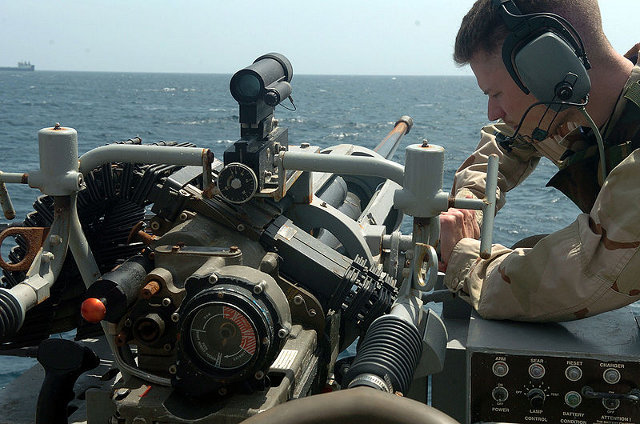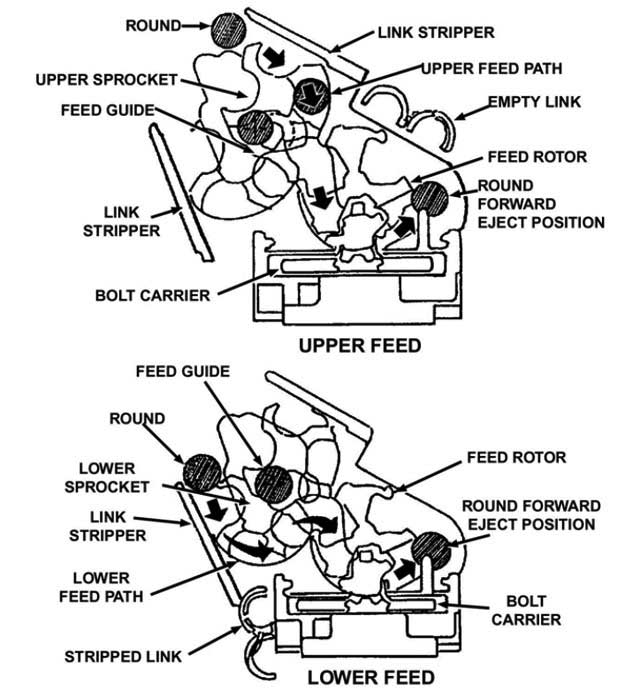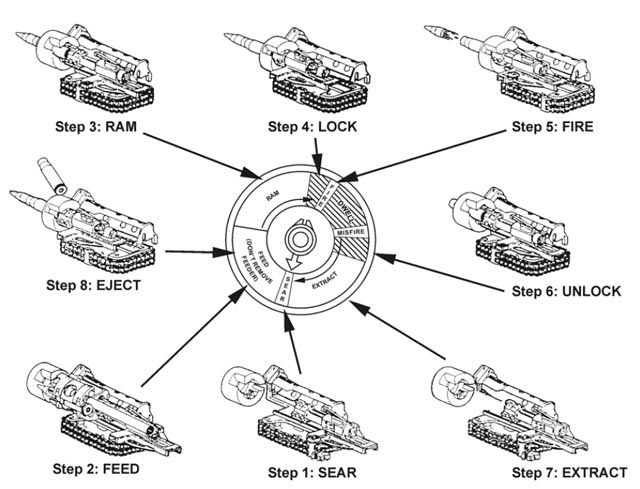Operation of the 25mm M-242 Automatic Gun

The above picture is for a naval mounted Mk. 38, and the description if from a Bradley Fighting Vehicle Manual. The guns are the same and you can see the Bolt Position Indicator on the rear of the gun.
The M-242 is a single barrel electrically operated chain gun. It is called a chain gun since an electric motor runs a double row chain over 4 sprockets that control the bolt and feed the gun. The gun can take on lightly armored vehicles, though it has been known to take out heavier ones, and helicopters, and is also used to suppress enemy positions, whether dug in or in the open.
Dual Feed system

The chain gun has a dual feed system that can pick and choose the ammunition from 2 separate ammo boxes. On the Bradley, one box holds 70 rounds and the other holds 230 rounds. The ammunition can be mixed between AP (armor piercing) or HE (high explosive). A system of clutches can pull ammo from either box, and the gun can be operated in single shot, low rate of fire (100rpm) or high rate (200rpm). The explosive gases from the gun are vented to the outside of the tank for the safety of the tank operators.
BPI (Bolt Position Indicator) and Cycles of Function

The gun has a gauge on the rear called the BPI (bolt position indicator) which shows the position of the bolt which is driven by the chain) at any time in its eight cycles of operation.
Step one: Sear or Charge Cycle. The bolt is just forward of its rearmost position. The firing pin remains uncocked. The BPI points to SEAR.
Step two: Feed Cycle. Linked ammunition enters the feed sprockets and the links are stripped off. The bolt is moved to the rear by 25mm and the feeder rotor turns 1/3 of a turn allowing the round positioner to place a round into the rotor. Absolute hang fire protection is activated.
Step three: Chamber or Ram Cycle. The rotor stops moving counterclockwise once the round is positioned on the bolt face. Bolt, carrier and round move forward till fully seated in the chamber. BPI points to RAM.
Step four: Lock Cycle. The bolt is driven home and locks in place, and the gun is ready to fire
Step five: Fire Cycle. The final movement of the bolt lets go of the firing pin, and the BPI points to FIRE. The gun doesn't need any recoil action from the fired shell to operate, but does trip a switch when recoilled by 12 mm or the BPI reads MISFIRE.
Step six: Unlock Cycle. Once past the MISFIRE position, the bolt unlocks and is carried to the rear by the chain driven slider. The BPI points to EXTRACT.
Step seven: Extract Cycle. The round is pulled to the rear with the bolt until it locks in the SEAR position. The BPI indicates SEAR.
Step eight: Eject Cycle. The expended shell remains locked to the bolt face till the gunner triggers another shot. When that happens the bolt moves to the FEED position, the rotor rotates a third of a turn, pushing the spent round into the eject chute and feeding another round. As the bolt rams home, the eject arm on the bolt carrier pushes the spent round out the chute in front of the gun. Wash, Rinse, Repeat.

